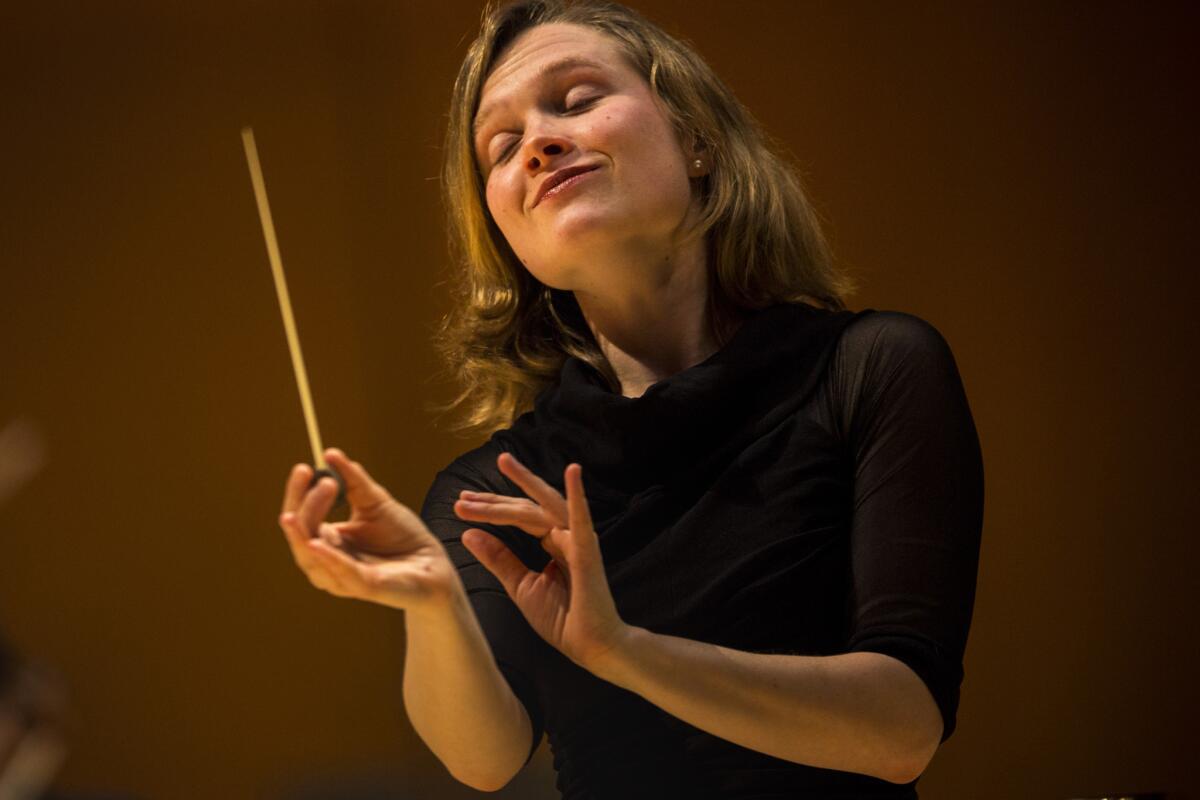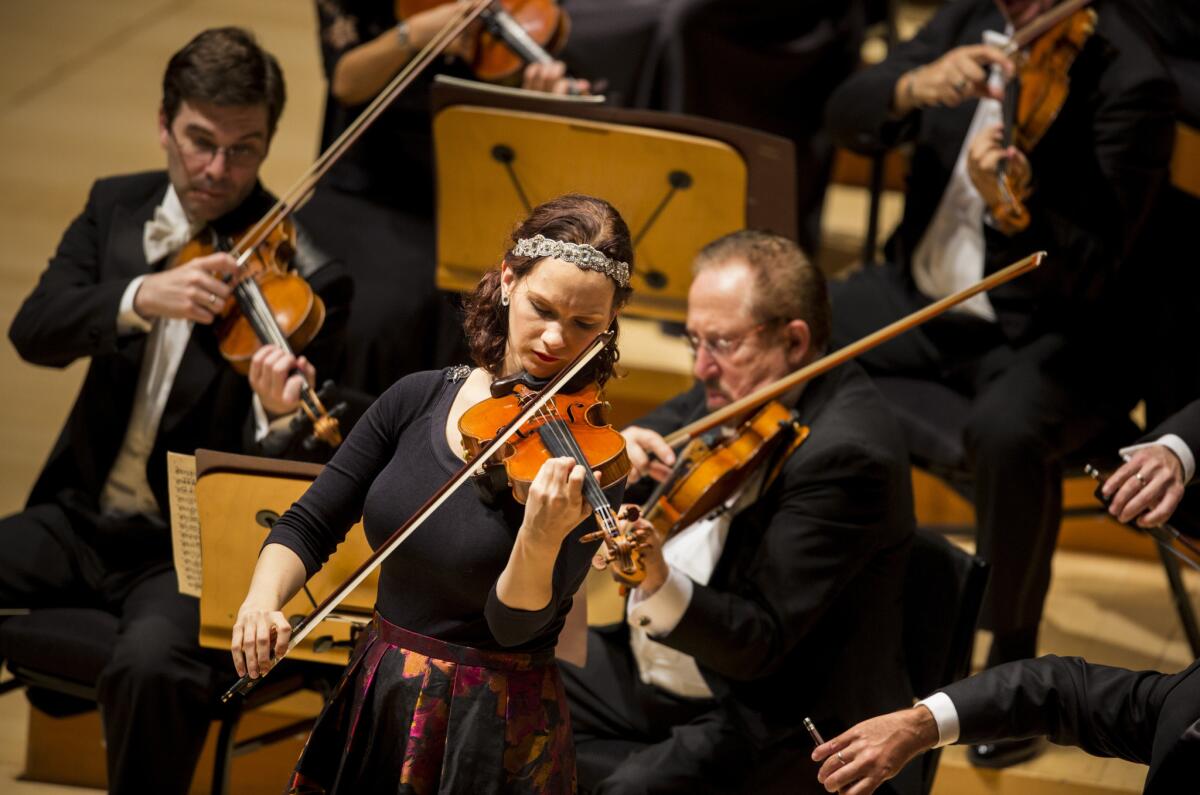Review: Mirga Gražinytė-Tyla shows why she’s moving up in latest L.A. Phil show at Disney Hall

Mirga Grazinyte-Tyla impresses again with Los Angeles Philharmonic, conducting three varied works at Disney Hall.
Mirga Grazinyte-Tyla’s job was twofold, or possibly threefold, at Walt Disney Concert Hall on Thursday night.
In the first half of the concert, the Los Angeles Philharmonic’s stellar young assistant conductor had heavy dusting to do, removing layers off a little-known ballet score from 1955 by Mieczyslaw Weinberg and then sweeping thick cobwebs off Henri Vieuxtemps Fourth Violin Concerto, which Hilary Hahn chose to play. After intermission, Grazinyte-Tyla had the opposite challenge: to find some reason for the L.A. Phil to play, yet again, Tchaikovsky’s Fourth Symphony.
SIGN UP for the free Essential Arts & Culture newsletter >>
The third job was a little less remarkable — namely, to further assert the reasons why she won’t remain an assistant conductor for much longer. But we already knew that from her latest appearances with the orchestra at the Hollywood Bowl last summer and her San Diego Symphony debut last weekend. She becomes the L.A. Phil’s associate conductor next year, and after that, well anything can, and is likely to, happen.
Her cap now has more feathers. All three jobs Thursday were excitingly accomplished, but the most important and most impressive was what she managed with Weinberg’s Suite No. 4 from “The Golden Key.” A Polish Jew born in 1919, the composer escaped the Nazi occupation of Warsaw in 1939 and spent the remaining 57 years of his life in Moscow. Known as Moishe Vainberg, he became the third most important Soviet composer after Prokofiev and Shostakovich (a champion and great influence), but he remained a distant third who never had much of a reputation in the West.
There is, however, a new interest in the prolific composer, who wrote 22 big symphonies, 17 string quartets and more than 40 Russian film scores (including “The Cranes Are Flying”). Among Weinberg’s most fervent champions is the violinist Gidon Kremer, who had wanted at the last minute to include a Weinberg violin sonata on his chamber music program at Disney Hall in January.
The L.A. Phil felt that would make the program too long. But Kremer may have subtly gotten Weinberg into Disney through Grazinyte-Tyla, the violinist having found a new enthusiast when he invited her to conduct the composer’s works with his Kremerata Baltica in Latvia.
“The Golden Key” suite can hardly be expected to stand up to the serious symphonies and chamber pieces, to say nothing of Weinberg’s terrible operatic depictions of Auschwitz in “The Passenger.” But there was a playful side to Weinberg, and the ballet includes dances for a rat and a cricket, and a pas de deux for a cat and a fox.

Violinist Hilary Hahn and the L.A. Phil at Walt Disney Concert Hall.
The score is colorful, especially in its use for solo winds, but the couple of recordings of it that have come out of Russia do not make it seem distinctive. Those recordings lie. Grazinyte-Tyla brought Weinberg to vivid life. She found here the precise combination of bright holiday sparkle and eccentric turns of phrase that made nothing seem predictable. Weinberg’s 22 symphonies — as do his klezmer-infused sinfoniettas — await her.
Vieuxtemps’ 19th century violin concertos were once the rage among the legendary virtuosos of yore. The Belgian composer, himself a great violinist whom some preferred to Paganini, knew how to dazzle. He could write a good tune. (The last movement of the Fourth Concerto verges on corn, but try to get rid of its melodic ear worm for a week after hearing it.)
Vieuxtemps might seem a strange composer for Hahn to revive. Her technique is flawless, but she has always been more successful at finding musical depth than providing cheap tricks. She certainly does nothing cheap with Vieuxtemps.
On exhibit, instead, were exquisite phrasing and her strong, intense sound. The technically hard stuff she made seem easy. But she didn’t make it particularly fun, as even the grim-faced Jascha Heifetz could do. But though having the reputation as a tough customer to conductors, Hahn showed an excellent rapport with Grazinyte-Tyla, who attended to making the most out of the French character of Vieuxtemps’ gracious orchestral writing. Still, it was Hahn’s encore of the “Loure” from Bach’s Third Solo Partita that showed the solo eloquent and euphoric best of her.
Oddly enough, Tchaikovsky’s Fourth was fun. The symphony has been romanticized to death, what with the long-suffering composer blaring out his fateful angst and supposedly overcoming his suicidal tendencies at the end. Even so, many conductors find even melancholic anger, or aggressive sadness, or manic-depressive whatever even in the Finale.
Grazinyte-Tyla had none of that. She enthusiastically jumped into the big symphony as though it were a mountain to be climbed. Death perhaps lurks around every corner — but those vistas are magnificent.
Adrenaline flowed rather than bile. Brass turned the opening cry of fate a battle cry. Grazinyte-Tyla found alluring ways of bringing out contrapuntal lines one might normally care about. Lyricism flowed without hindrance, and rhythms popped. The Finale was a race against the clock.
This was Grazinyte-Tyla’s first Tchaikovsky’s Fourth and something like the orchestra’s millionth. She will find more substance in it with time. But her wonderful exploit here was to share with players and any jaded listeners in the hall the joys of discovery. The orchestra played as though it too were young again, as even the belovedly disconsolate Tchaikovsky once was.
-----------------------
Mirga Grazinyte-Tyla and the Los Angeles Philharmonic
Where: Walt Disney Concert Hall, 111. S. Grand Ave., Los Angeles
When: 8 p.m. Saturday
Cost: $26.50-$203.50
Info: (323) 850-2000 or www.laphil.org
More to Read
The biggest entertainment stories
Get our big stories about Hollywood, film, television, music, arts, culture and more right in your inbox as soon as they publish.
You may occasionally receive promotional content from the Los Angeles Times.











